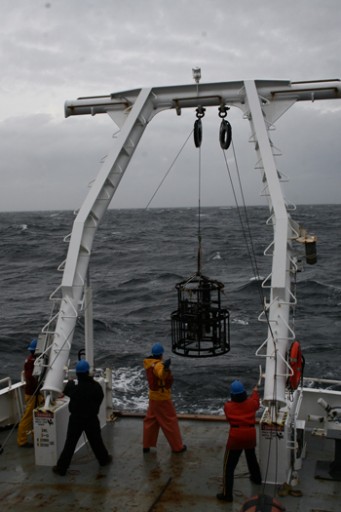Marine robots detect endangered whales
January 15, 2013

While the robot “gliders” run their surveys, the team aboard Endeavor works in rough seas to deploy a video plankton recorder, an instrument that helps them assess the availability of food for baleen whales (credit: Nadine Lysiak/Woods Hole Oceanographic Institution)
Two robots equipped with instruments designed to “listen” for the calls of baleen whales detected nine endangered North Atlantic right whales in the Gulf of Maine last month.
The team of researchers, led by Woods Hole Oceanographic Institution (WHOI) scientists Mark Baumgartner and Dave Fratantoni, reported their sightings to NOAA, the federal agency responsible for enforcing the Marine Mammal Protection Act.
NOAA Fisheries Service, in turn, put in place on Dec. 5 a “dynamic management area,” asking mariners to voluntarily slow their vessel speed to avoid striking the animals.
“Gliders” robots
The project employed ocean-going robots called gliders equipped with a digital acoustic monitoring (DMON) instrument and specialized software allowing the vehicle to detect and classify calls from four species of baleen whales — sei, fin, humpback, and right whales.
The gliders’s real-time communication capabilities alerted scientists to the presence of whales in the research area, in the first successful use of technology to report detections of several species of baleen whales from autonomous vehicles.
The innovative whale detection system provides conservation managers with a cost-effective alternative to ship- or plane-based means of identifying the presence of whales, and gives whale ecologists new tools for understanding large animals that spend most of their lives out of human eyesight below the sea surface.
The labor-intensive work of surveying for whales, overseen by NOAA, is usually done by human observers on ships or airplanes, and is limited by the conditions at sea.
Gliders — approx. six-foot-long, torpedo-shaped autonomous vehicles with short wings — have been in use by oceanographers for about a decade. They move up, down, and laterally in a sawtooth pattern through the water by changing their buoyancy and using their wings to provide lift.
Battery powered and exceptionally quiet in the water, the gliders are equipped with an underwater microphone on the underside of the vehicle near its wings, and an iridium satellite antenna on the tail section. The vehicle surfaces every few hours to get a GPS position and transmit data to shore-side computers.
The DMON — a circuit board and battery about the size of an iPhone — sits inside the glider recording audio and generating spectrograms, a form of the audio that facilitates complex sound analysis. From the spectrogram, Baumgartner’s software generates a “pitch track,” a visual representation of a whale call, and estimates which species of whale made the call based on characteristics of the pitch track.
Tallies of each species’ detected calls and even a small subset of detected pitch tracks can be transmitted to shore by the vehicle.